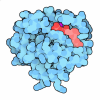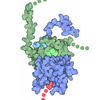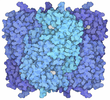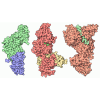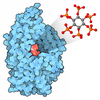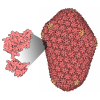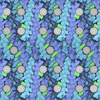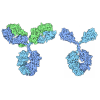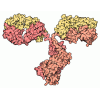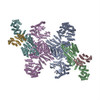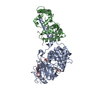+ Open data
Open data
- Basic information
Basic information
| Entry | Database: PDB / ID: 9b9g | |||||||||||||||||||||||||||||||||||||||
|---|---|---|---|---|---|---|---|---|---|---|---|---|---|---|---|---|---|---|---|---|---|---|---|---|---|---|---|---|---|---|---|---|---|---|---|---|---|---|---|---|
| Title | Structure of the PI4KA complex bound to Calcineurin | |||||||||||||||||||||||||||||||||||||||
 Components Components |
| |||||||||||||||||||||||||||||||||||||||
 Keywords Keywords | SIGNALING PROTEIN / PI4KIIIa complex / PI4KA / TTC7B / FAM126A / CNA / CNB / Calcineurin | |||||||||||||||||||||||||||||||||||||||
| Function / homology |  Function and homology information Function and homology informationreorganization of cellular membranes to establish viral sites of replication / Synthesis of PIPs at the ER membrane / negative regulation of angiotensin-activated signaling pathway / calcium-dependent protein serine/threonine phosphatase regulator activity / regulation of cell proliferation involved in kidney morphogenesis / positive regulation of glomerulus development / negative regulation of calcium ion import across plasma membrane / negative regulation of signaling / calcium-dependent protein serine/threonine phosphatase activity / 1-phosphatidylinositol 4-kinase ...reorganization of cellular membranes to establish viral sites of replication / Synthesis of PIPs at the ER membrane / negative regulation of angiotensin-activated signaling pathway / calcium-dependent protein serine/threonine phosphatase regulator activity / regulation of cell proliferation involved in kidney morphogenesis / positive regulation of glomerulus development / negative regulation of calcium ion import across plasma membrane / negative regulation of signaling / calcium-dependent protein serine/threonine phosphatase activity / 1-phosphatidylinositol 4-kinase / 1-phosphatidylinositol 4-kinase activity / positive regulation of saliva secretion / peptidyl-serine dephosphorylation / calmodulin-dependent protein phosphatase activity / calcineurin complex / positive regulation of calcium ion import across plasma membrane / positive regulation of calcium ion-dependent exocytosis of neurotransmitter / positive regulation of connective tissue replacement / positive regulation of cardiac muscle hypertrophy in response to stress / negative regulation of dendrite morphogenesis / protein serine/threonine phosphatase complex / renal filtration / lung epithelial cell differentiation / Synthesis of PIPs at the Golgi membrane / calcineurin-NFAT signaling cascade / host-mediated perturbation of viral process / Golgi-associated vesicle membrane / positive regulation of calcineurin-NFAT signaling cascade / skeletal muscle tissue regeneration / phosphatidylinositol biosynthetic process / transition between fast and slow fiber / myelination in peripheral nervous system / positive regulation of osteoclast differentiation / cardiac muscle hypertrophy in response to stress / regulation of synaptic vesicle cycle / dephosphorylation / extrinsic component of plasma membrane / CLEC7A (Dectin-1) induces NFAT activation / branching involved in blood vessel morphogenesis / dendrite morphogenesis / protein-serine/threonine phosphatase / phosphatidylinositol-mediated signaling / regulation of postsynaptic neurotransmitter receptor internalization / parallel fiber to Purkinje cell synapse / phosphatidylinositol phosphate biosynthetic process / calcineurin-mediated signaling / protein serine/threonine phosphatase activity / positive regulation of activated T cell proliferation / positive regulation of endocytosis / Calcineurin activates NFAT / epithelial to mesenchymal transition / DARPP-32 events / epidermis development / Activation of BAD and translocation to mitochondria / positive regulation of osteoblast differentiation / phosphatase binding / multicellular organismal response to stress / postsynaptic modulation of chemical synaptic transmission / protein dephosphorylation / keratinocyte differentiation / skeletal muscle fiber development / myelination / FCERI mediated Ca+2 mobilization / positive regulation of cell adhesion / T cell activation / hippocampal mossy fiber to CA3 synapse / protein localization to plasma membrane / excitatory postsynaptic potential / wound healing / G1/S transition of mitotic cell cycle / response to calcium ion / sarcolemma / modulation of chemical synaptic transmission / Schaffer collateral - CA1 synapse / Z disc / protein import into nucleus / calcium ion transport / heart development / ATPase binding / Ca2+ pathway / dendritic spine / calmodulin binding / postsynapse / neuron projection / protein dimerization activity / positive regulation of cell migration / cadherin binding / protein domain specific binding / negative regulation of gene expression / focal adhesion / calcium ion binding / positive regulation of gene expression / glutamatergic synapse / enzyme binding / signal transduction / positive regulation of transcription by RNA polymerase II / mitochondrion / extracellular exosome / nucleoplasm / ATP binding Similarity search - Function | |||||||||||||||||||||||||||||||||||||||
| Biological species |  Homo sapiens (human) Homo sapiens (human) | |||||||||||||||||||||||||||||||||||||||
| Method | ELECTRON MICROSCOPY / single particle reconstruction / cryo EM / Resolution: 3.5 Å | |||||||||||||||||||||||||||||||||||||||
 Authors Authors | Shaw, A.L. / Suresh, S. / Yip, C.K. / Burke, J.E. | |||||||||||||||||||||||||||||||||||||||
| Funding support |  Canada, 2items Canada, 2items
| |||||||||||||||||||||||||||||||||||||||
 Citation Citation |  Journal: Structure / Year: 2024 Journal: Structure / Year: 2024Title: Structure of calcineurin bound to PI4KA reveals dual interface in both PI4KA and FAM126A. Authors: Alexandria L Shaw / Sushant Suresh / Matthew A H Parson / Noah J Harris / Meredith L Jenkins / Calvin K Yip / John E Burke /  Abstract: Phosphatidylinositol 4-kinase alpha (PI4KA) maintains the phosphatidylinositol 4-phosphate (PI4P) and phosphatidylserine pools of the plasma membrane. A key regulator of PI4KA is its association into ...Phosphatidylinositol 4-kinase alpha (PI4KA) maintains the phosphatidylinositol 4-phosphate (PI4P) and phosphatidylserine pools of the plasma membrane. A key regulator of PI4KA is its association into a complex with TTC7 and FAM126 proteins. This complex can be regulated by the CNAβ1 isoform of the phosphatase calcineurin. We previously identified that CNAβ1 directly binds to FAM126A. Here, we report a cryoelectron microscopic (cryo-EM) structure of a truncated PI4KA complex bound to calcineurin, revealing a unique direct interaction between PI4KA and calcineurin. Hydrogen deuterium exchange mass spectrometry (HDX-MS) and computational analysis show that calcineurin forms a complex with an evolutionarily conserved IKISVT sequence in PI4KA's horn domain. We also characterized conserved LTLT and PSISIT calcineurin binding sequences in the C terminus of FAM126A. These dual sites in PI4KA and FAM126A are both in close proximity to phosphorylation sites in the PI4KA complex, suggesting key roles of calcineurin-regulated phosphosites in PI4KA regulation. This work reveals novel insight into how calcineurin can regulate PI4KA activity. | |||||||||||||||||||||||||||||||||||||||
| History |
|
- Structure visualization
Structure visualization
| Structure viewer | Molecule:  Molmil Molmil Jmol/JSmol Jmol/JSmol |
|---|
- Downloads & links
Downloads & links
- Download
Download
| PDBx/mmCIF format |  9b9g.cif.gz 9b9g.cif.gz | 1.1 MB | Display |  PDBx/mmCIF format PDBx/mmCIF format |
|---|---|---|---|---|
| PDB format |  pdb9b9g.ent.gz pdb9b9g.ent.gz | 878.2 KB | Display |  PDB format PDB format |
| PDBx/mmJSON format |  9b9g.json.gz 9b9g.json.gz | Tree view |  PDBx/mmJSON format PDBx/mmJSON format | |
| Others |  Other downloads Other downloads |
-Validation report
| Summary document |  9b9g_validation.pdf.gz 9b9g_validation.pdf.gz | 1.4 MB | Display |  wwPDB validaton report wwPDB validaton report |
|---|---|---|---|---|
| Full document |  9b9g_full_validation.pdf.gz 9b9g_full_validation.pdf.gz | 1.5 MB | Display | |
| Data in XML |  9b9g_validation.xml.gz 9b9g_validation.xml.gz | 167.8 KB | Display | |
| Data in CIF |  9b9g_validation.cif.gz 9b9g_validation.cif.gz | 258.8 KB | Display | |
| Arichive directory |  https://data.pdbj.org/pub/pdb/validation_reports/b9/9b9g https://data.pdbj.org/pub/pdb/validation_reports/b9/9b9g ftp://data.pdbj.org/pub/pdb/validation_reports/b9/9b9g ftp://data.pdbj.org/pub/pdb/validation_reports/b9/9b9g | HTTPS FTP |
-Related structure data
| Related structure data |  44382MC M: map data used to model this data C: citing same article ( |
|---|---|
| Similar structure data | Similarity search - Function & homology  F&H Search F&H Search |
- Links
Links
- Assembly
Assembly
| Deposited unit | 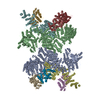
|
|---|---|
| 1 |
|
- Components
Components
-Protein , 5 types, 10 molecules ABDFEGHJIK
| #1: Protein | Mass: 237102.281 Da / Num. of mol.: 2 Source method: isolated from a genetically manipulated source Source: (gene. exp.)  Homo sapiens (human) / Gene: PI4KA, PIK4, PIK4CA / Production host: Homo sapiens (human) / Gene: PI4KA, PIK4, PIK4CA / Production host:  References: UniProt: P42356, 1-phosphatidylinositol 4-kinase #2: Protein | Mass: 94294.109 Da / Num. of mol.: 2 Source method: isolated from a genetically manipulated source Source: (gene. exp.)  Homo sapiens (human) / Gene: TTC7B, TTC7L1 / Production host: Homo sapiens (human) / Gene: TTC7B, TTC7L1 / Production host:  #3: Protein | Mass: 34638.867 Da / Num. of mol.: 2 Source method: isolated from a genetically manipulated source Details: Truncated construct (1-308) / Source: (gene. exp.)  Homo sapiens (human) / Gene: HYCC1, DRCTNNB1A, FAM126A / Production host: Homo sapiens (human) / Gene: HYCC1, DRCTNNB1A, FAM126A / Production host:  #4: Protein | Mass: 19322.904 Da / Num. of mol.: 2 Source method: isolated from a genetically manipulated source Source: (gene. exp.)  Homo sapiens (human) / Gene: PPP3R1, CNA2, CNB / Production host: Homo sapiens (human) / Gene: PPP3R1, CNA2, CNB / Production host:  #5: Protein | Mass: 70883.242 Da / Num. of mol.: 2 / Mutation: L236P,D238N Source method: isolated from a genetically manipulated source Details: Truncated Calcineurin A alpha (2-391) L236P D238N,Truncated Calcineurin A alpha (2-391) L236P D238N Source: (gene. exp.)  Homo sapiens (human) / Gene: PPP3CA, CALNA, CNA / Production host: Homo sapiens (human) / Gene: PPP3CA, CALNA, CNA / Production host:  References: UniProt: Q08209, protein-serine/threonine phosphatase |
|---|
-Non-polymers , 1 types, 8 molecules 
| #6: Chemical | ChemComp-CA / |
|---|
-Details
| Has ligand of interest | N |
|---|---|
| Has protein modification | N |
-Experimental details
-Experiment
| Experiment | Method: ELECTRON MICROSCOPY |
|---|---|
| EM experiment | Aggregation state: PARTICLE / 3D reconstruction method: single particle reconstruction |
- Sample preparation
Sample preparation
| Component | Name: PI4KA complex bound to Calcineurin / Type: COMPLEX / Details: Stabilized with BS3 crosslinker / Entity ID: #1-#5 / Source: RECOMBINANT | |||||||||||||||||||||||||
|---|---|---|---|---|---|---|---|---|---|---|---|---|---|---|---|---|---|---|---|---|---|---|---|---|---|---|
| Molecular weight | Experimental value: NO | |||||||||||||||||||||||||
| Source (natural) | Organism:  Homo sapiens (human) Homo sapiens (human) | |||||||||||||||||||||||||
| Source (recombinant) | Organism:  | |||||||||||||||||||||||||
| Buffer solution | pH: 7 Details: Freshly prepared gel filtration buffer, filtered through 0.22um filter and degassed | |||||||||||||||||||||||||
| Buffer component |
| |||||||||||||||||||||||||
| Specimen | Conc.: 0.77 mg/ml / Embedding applied: NO / Shadowing applied: NO / Staining applied: NO / Vitrification applied: YES Details: Sample was treated with BS3 crosslinker then gel filtered to isolate protein peak consistent with a dimer of pentamers. | |||||||||||||||||||||||||
| Specimen support | Details: Glow discharged using the Pelco EasiGlow. 15mA Current. Grid material: COPPER / Grid mesh size: 300 divisions/in. / Grid type: C-flat-2/1 | |||||||||||||||||||||||||
| Vitrification | Instrument: FEI VITROBOT MARK IV / Cryogen name: ETHANE / Humidity: 100 % / Chamber temperature: 277.15 K / Details: Blot force -5, blot time 1 s |
- Electron microscopy imaging
Electron microscopy imaging
| Experimental equipment |  Model: Titan Krios / Image courtesy: FEI Company |
|---|---|
| Microscopy | Model: TFS KRIOS |
| Electron gun | Electron source:  FIELD EMISSION GUN / Accelerating voltage: 300 kV / Illumination mode: FLOOD BEAM FIELD EMISSION GUN / Accelerating voltage: 300 kV / Illumination mode: FLOOD BEAM |
| Electron lens | Mode: BRIGHT FIELD / Nominal magnification: 165000 X / Nominal defocus max: 2000 nm / Nominal defocus min: 1000 nm / Cs: 2.7 mm |
| Specimen holder | Cryogen: NITROGEN / Specimen holder model: FEI TITAN KRIOS AUTOGRID HOLDER |
| Image recording | Electron dose: 50 e/Å2 / Film or detector model: FEI FALCON IV (4k x 4k) / Num. of grids imaged: 1 / Num. of real images: 10121 |
| EM imaging optics | Energyfilter name: TFS Selectris |
- Processing
Processing
| EM software |
| ||||||||||||||||||||||||||||
|---|---|---|---|---|---|---|---|---|---|---|---|---|---|---|---|---|---|---|---|---|---|---|---|---|---|---|---|---|---|
| CTF correction | Type: PHASE FLIPPING AND AMPLITUDE CORRECTION | ||||||||||||||||||||||||||||
| Particle selection | Num. of particles selected: 1181312 Details: Particles were picked using the cryoSPARC template picker | ||||||||||||||||||||||||||||
| Symmetry | Point symmetry: C2 (2 fold cyclic) | ||||||||||||||||||||||||||||
| 3D reconstruction | Resolution: 3.5 Å / Resolution method: FSC 0.143 CUT-OFF / Num. of particles: 235760 / Symmetry type: POINT | ||||||||||||||||||||||||||||
| Atomic model building |
| ||||||||||||||||||||||||||||
| Refine LS restraints |
|
 Movie
Movie Controller
Controller



 PDBj
PDBj
